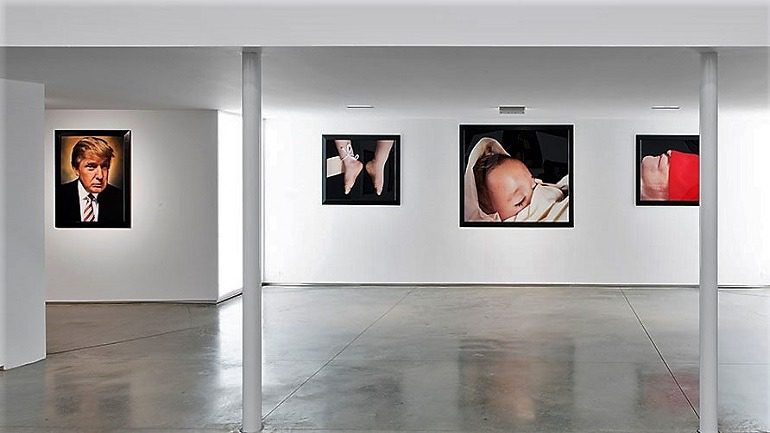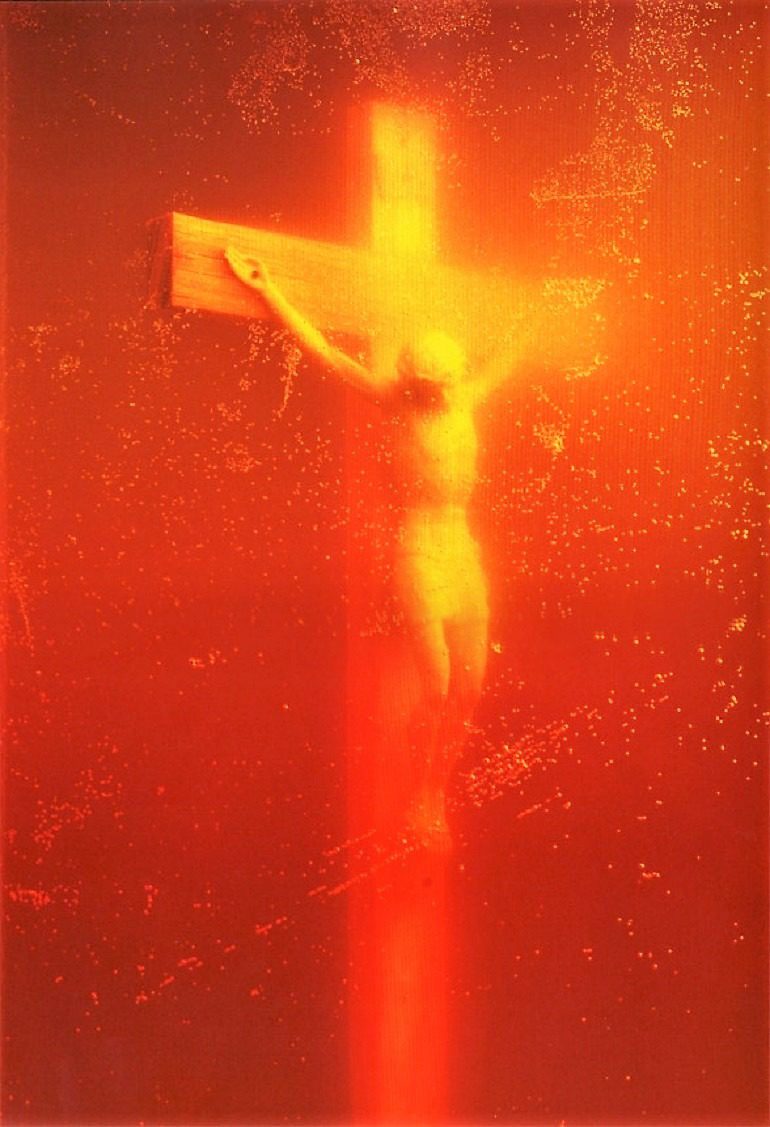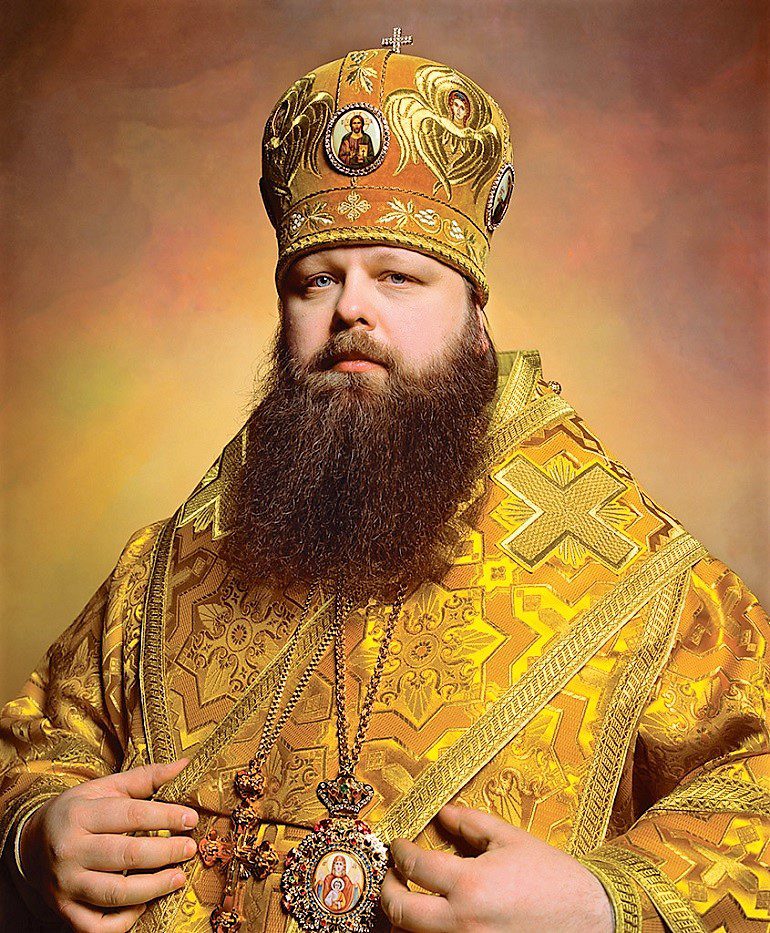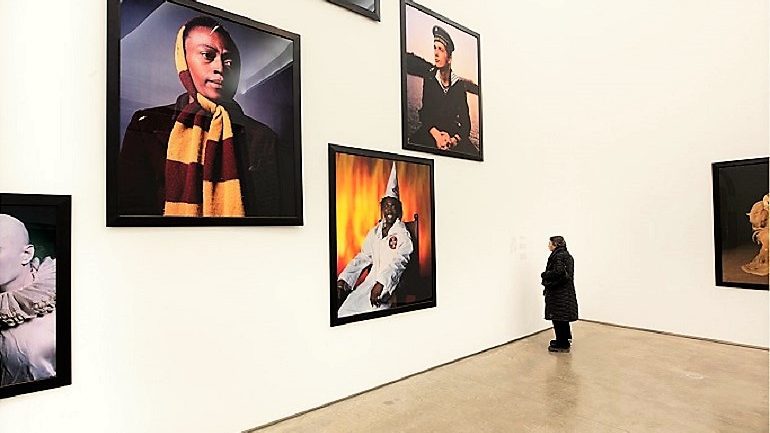ART & DESIGN
Andres Serrano photograph of Ku Klux Klan member captivates a female guest during his exhibition at the Jack Shainman Gallery
ART REVIEW
Andres Serrano: Selected Works 1984-2015, at the Jack Shainman Gallery in New York reveals the trivialities of human existences.
BY KAZAD

Andres Serrano, Portrait of Donald Trump with photographs of dead people. Installation view: Jack Shainman Gallery
NEW YORK, NY- Andres Serrano: Selected Works 1984-2015, at the Jack Shainman Gallery is a reminder of the artist’s consistent quest to cross all artistic boundaries. The exhibition includes past and recent works by the very controversial artist, showing how he transcends established boundaries and accepted norms in the medium of photography.
The show includes selected photographs from various series, including America (2001-2004), a panorama of American society, The Morgue (1992), an investigation of death, History of Sex (1995-1996), graphic images which have been taped to repair previous vandalism, and Torture (2015). Andres Serrano: Selected Works 1984-2015 also includes new works by the artist, including his series on the homeless.
ART NEWS | READ ALSO: Photographer Trevor Paglen Wins Award for Surveillance Photographs
Andres Serrano began drawing attention to the problems of the homeless more than 25 years ago. In 1990, he created a series of photos he called Nomads. The subjects were homeless people posed against studio backgrounds set up inside subway stations.
Signs of the Times followed Nomads. For this 2013 project, Andres bought more than 200 signs that homeless people used to solicit change from passing pedestrians. He returned to the subject of the homeless in 2014, but this time his focus was on New York. The objective of the new project, which he called Residents of New York, was to bring attention to homeless New Yorkers who are often ignored in the hustle and bustle of New York life. For this project, Andres created a series of portraits that are both captivating and revealing.
One of the portraits in this series is that of a Vietnam veteran called John M. Lavery. The black and white photograph captures John in what looks like his natural environment. Dressed in a black winter coat, John has in his hand a cup and a sign that indicates that he is a homeless veteran. His face tells a lot of stories: stories of disenchantment and pain. Heavy bags drool under his eyes with no place to settle. His dishevel face carry well-etched wrinkles with pride. Yet, there is great pride in this man who has battled earth, wind, and fire. His poise and alertness indicate a man able to stand tall in the face of adversities.
Pride, dignity, and strength are the focus of the portrait of Stephanie Green, a homeless woman in New York. Dressed a black sweater, she has on a matching red hat and a scarf. Her gaze is piercing and her expression sober. Like many of the other homeless people captured by Andres Serrano, Stephanie’s expression shows pain and frustration. Nonetheless, pride written all over her. Sitting in a corner, her expression depicts a dogged quest to internalization her pain. Stephanie’s beautiful eyes tell the story of a beauty ravaged by pain and a tortured existence, yet, her aura exudes dignity.
Since the election of Donald Trump, stories of race inequality have become major topics of discussions. The role of Ku Klux Klan in the race wars has also gained new attention. The resurgence of race war post-Obama gives credence to Andres Serrano’s series on Ku Klux Klan. One of the images captures Klansman Great Titan of the Invisible Empire, 1990 and Grand Kaliff II-Knights of the KKK, 1990. In their full regalia, the men show arrogance now associated with “white power.” The exhibition also includes bodily fluids, including, blood and water.
Included in the show are portraits of dignitaries and everyday people. Andres’ portrait of Trump is one of the images of dignitaries in the show. Photographs of other notables on display include Wunmi Fadipe, Sales Assistant at Investments Bank and Snoop Dog. The portrait of American (Bishop Mercurius of Russian Orthodox Church in New York), taken in 2002 shows power. The portraits and other photographs in the show allow an insight into the complex nature of human existence. While some are abjectly poor, others are extremely rich.The exhibition also includes bodily fluids, including, blood and water.
Love, hate, death, sex are at the core of Andres Serrano: Selected Works 1984-2015. Tormenting as some of the images are, they reveal the good, the bad and the ugly realities of human existence. They are images of our journey as a society. “Much of Andres’ historic work comes out of the late ‘80s and early ‘90s, so it’s interesting to consider how far we’ve come as a society since then,” said Shainman during the show opening. The fact that the issues addressed by the images continue to dominate contemporary discussions, Shainman notes, shows “How frustrating it can feel that we’re having similar conversations now regarding morality and freedom. The work addresses the parts of life that are uncomfortable and ever-present; they are issues that are forever with us.”
With his work, Andres Serrano directly confronts race relations, community values, religious sects, corporeality, sexuality and political order. Some of his works have created unfathomable storms. An important example is Piss Christ (1987). Piss Christ is the picture of an ethereal image of a Crucifix submerged in the artist’s urine. The controversial work engendered the cultural wars of 1989.
Piss Christ: Andres Serrano’s controversial photograph of a Crucifix submerged in the artist’s urine.

Andres Serrano’s Piss Christ was a majore souce of controversy when it was shown in New York. Image: Artist
Piss Christ engendered a national debate on the freedom of artistic expression and the public funding of controversial art. Born in 1950 in New York City, Andres Serrano attended the Brooklyn Museum Art School from 1967 60 1969. There, he studied painting and sculpture. An internationally acclaimed artist, Andres Serrano has exhibited in major art institutions across the globe. His photographs are also in important art institutions and major collections, including Institute of Contemporary Art, Boston, MA; Museum of Modern Art, New York; capc musée d’art contemporain, Bordeaux, France and many others.
Born in 1950 in New York City, Andres Serrano attended the Brooklyn Museum Art School from 1967 60 1969. There, he studied painting and sculpture. An internationally acclaimed artist, Andres Serrano has exhibited in major art institutions across the globe. His photographs are also in important art institutions and major collections, including Institute of Contemporary Art, Boston, MA; Museum of Modern Art, New York; capc musée d’art contemporain, Bordeaux, France and many others.

Andres Serrano, Mercurius of The Russian Orthodox Church in New York. Image: Jack Shainman Gallery
Join the art conversation: Share your thoughts and comments. Facebook– Twitter–Google+
